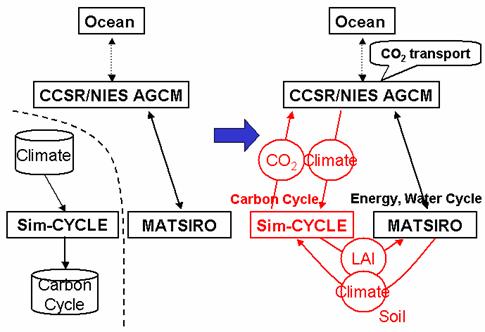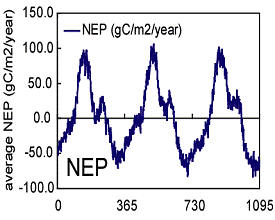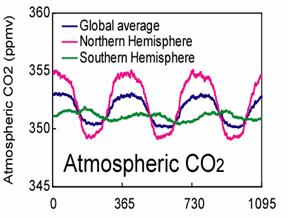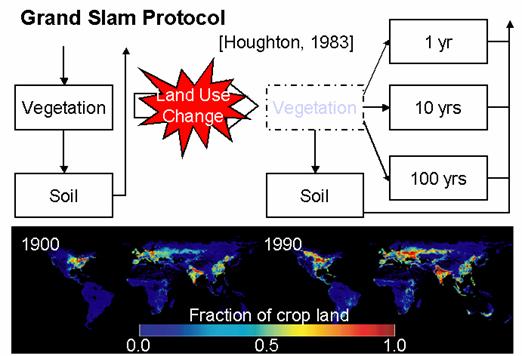1. Carbon cycle model, carbon cycle and climatic change joint modelResults Page | Top Page |
|||||||||
1-1. Terrestrial carbon cycle modelThe organization in charge: Earth frontier research system
a. SummaryIt is the target of this subgroup to include in the earth system integrated model which builds the model which simulates the carbon cycle by a terrestrial ecosystem, and is built with this subject when building the earth environment change forecasting model by artificial greenhouse gas discharge, and to perform warming prediction. In FY 2003, three points of examination 、 of the model extension for off-line evaluation of (1) Sim-CYCLE, the inclusion to AGCM of (2) terrestrial model, and both (3) integrated models comparison project participation were performed. b. Research purposethe carbon balance of the present earth -- setting -- being artificial (fossil fuel consumption, land use change, etc.) -- an abbreviation half remains in the atmosphere among the discharged carbon dioxide (they will be about 7 PgC(s)/a year at the 1980s), and the remaining half is absorbed by the ocean and terrestrial. The terrestrial ecosystem has played the role important for the carbon balance of the earth also from a global aspect. However, in the present carbon cycle research, the carbon balance of a terrestrial ecosystem has many unsolved problems, and is further considered to be one of the factors which enlarge uncertainty of prediction also in the future earth environment change prediction by greenhouse gas discharge. If some researches using an earth system integrated model are compared, future carbon dioxide levels and climate change prediction change greatly with between models (for example, Friedlingstein et al.2003), and the difference in the response of the carbon balance to earth environment change of a terrestrial ecosystem is considered to be one big factor. The purpose of this subgroup is including in the earth system integrated model which builds the model which is more highly precise and presumes (1) terrestrial ecosystem carbon cycle, and is built in (2) this subjects. Although breathing by the photosynthesis and the plant by a plant, and edaphone is main as carbon balance between the atmosphere and terrestrial vegetation, in order to reproduce a long-term ecosystem, it is necessary to take into consideration the complicated various process in the inside of an ecosystem. It is rare to be solved about those physiological ecology character, and although derivation of a general model leaves an experiential portion from a difficult thing, it needs to aim at parameterization with few errors. Therefore, modeling is advanced, promoting the observation project and cooperation of symbiosis 3rd (terrestrial ecosystem) etc. If in charge of inclusion to an earth system integrated model, the more reliable simulation in consideration of the interaction of climate and a carbon cycle becomes possible by combining a terrestrial carbon cycle model to the present air-sea joint general circulation model (AOGCM). For example, if it may work in the direction which vegetation absorbs more COs2 by extending the vegetation growing season in a cold district by warming, and eases CO2 concentration rise, a soil organic matter decomposition rate accelerates by warming, and CO2 concentration rise may be promoted. The simulation in consideration of the link of such climates and carbon cycles becomes possible. c. A research program, a method, and a schedule- FY 2002 〜 2004 : simple substance evaluation of a terrestrial modelOn the occasion of construction of an earth system integrated model, each component fully needs to be verified. About verification of a model, he is the ground observation group of the (1) symbiosis 3rd (terrestrial), the young woman using the continuation observational data of the water, the heat, and carbon-dioxide exchange between air-terrestrial by the flux group of the Ministry of Environment general research promotion expense S1 etc. -- comparison of the satellite observational data (LAI, absorptance of photosynthetically active radiation, photosynthesis quantity of production of vegetation) of broad-based vegetation activity and a model point estimate by the satellite observation group of verification of a product base and the (2) symbiosis 3rd (terrestrial) etc. is performed. Off-line evaluation of a model is performed in parallel to verification of the above-mentioned model. The carbon balance in the past - the present global scale is reproduced, and change of the terrestrial carbon cycle under future carbon dioxide levels and climate change scenario conditions is simulated. The elucidation by an off-line simulation is advanced about the factor of the uncertainty of the future prediction in the present integrated model research using the climate scenario reproduced under various greenhouse gas discharge scenario conditions. - FY2002 〜 2004 : combination to construction and the general circulation model of a terrestrial integrated modelIt is most efficiently attained by this group in construction of a terrestrial integrated model by combining the both model of the Sim-CYCLE model (Ito and Oikawa, 2002) reproducing a carbon cycle, and the MATSIRO model (Takata et al., 2003) reproducing heat and a water cycle. About the interaction of air-terrestrial, MATSIRO calculates heat and water exchange, and a photosynthetic rate based on LAI by Sim-CYCLE. Based on the amount of photosynthesis by the MATSIRO, Sim-CYLE calculates many process inside ecosystems, such as distribution to each part of vegetation, consumption by breathing or withering to death, and decomposition in soil. That is, it has a complementary relation of obtaining the net amount of exchange as the sum total because MATSIRO presumes the CO2 absorption to terrestrial from the atmosphere and Sim-CYCLE presumes the CO2 discharge from terrestrial. - FY2004 〜 2006As a next stage, extension for taking structural change of a terrestrial ecosystem into consideration is performed. The more nearly actually near prediction experiment in consideration of composition change of the vegetable types (an evergreen broad-leaved tree, a shrub, grassy place, etc.) which constitute an ecosystem from linking with the dynamic vegetation distributed model which the terrestrial dynamic state subgroup of this subject develops is conducted. It is made to converge on the integrative model about MATSIRO, Sim-CYCLE, and terrestrial that linked the vegetation dynamic model. The prediction experiment by the integrated model which finally introduced the influence which a water heat budget-carbon balance-vegetation change in structuretextural change has on a climate system is conducted. d. The research program in FY 2003This fiscal year performs three points of examination 、 of the model extension for (1) Sim-CYCLE off-line evaluation, the inclusion to AGCM of (2) terrestrial model, and both (3) integrated models comparison project participation. It is as follows for details. (1) Sim-CYCLE off-line evaluationAbout the factor which brings about un-deciding [ of future prediction of a terrestrial carbon cycle ], four points, the uncertainty of model structure, the uncertainty of a model parameter, the uncertainty of a future climatic prediction, and the uncertainty of a future greenhouse gas delivery, can be considered. It evaluates [ uncertainty / of the structure of a model ] using Sim-CYCLE about three points, the uncertainty of a model parameter, the uncertainty of a future climatic prediction, and the uncertainty of a future greenhouse gas delivery, noting that it is performed across boundaries by various endowed institutions by C4MIP (The Coupled Climate-Carbon Cycle Model Intercomparison Project: both carbon cycle-climate joint models comparison project) etc. (2) Inclusion to AGCM of a terrestrial modelIn order to build the integrated model of a carbon cycle and climate, combination of CCSR/NIES GCM (MATSIRO) and Sim-CYCLE is performed. The examination matter in the last fiscal year is followed, and the joint model of AGCM and a terrestrial carbon cycle is built through LAI, soil moisture, soil temperature, etc. in the form which carries out mutual interpolation of Sim-CYCLE and the MATSIRO through the coupler contained in GCM. (3) Examination of the model extension for both integrated models comparison project participationAlong with the protocol of both the integrated models comparison project, the additional component for performing a model simulation is examined. Specifically, expression of the carbon balance by land use change and reappearance [ of air CO2 concentration using an air transportation model ] 、 are considered to be required additional components. e. Reports in FY 2003The research program was followed and three points of examination 、 of the model extension for (1) Sim-CYCLE off-line evaluation, the inclusion to AGCM of (2) terrestrial model, and both (3) integrated models comparison project participation were performed. Details are shown below. e.1. Sim-CYCLE off-line evaluationIt continued at the last fiscal year, terrestrial carbon cycle model Sim-CYCLE was used, and the simulation of the future terrestrial ecosystem carbon cycle change under artificial greenhouse gas discharge scenario conditions was performed. In the simulation research in the present integrated model, it is thought that the carbon balance of a terrestrial ecosystem is a component with the highest uncertainty. About the factor which brings about un-deciding [ of future prediction of a terrestrial carbon cycle ], there are four points of the uncertainty of (1) model structure, the uncertainty of (2) model parameter, and the uncertainty of the greenhouse gas delivery of the uncertainty of a future climatic prediction and (3) (4) future. Although the uncertainty of the structure of a model is due to be performed by C4MIP etc. by various endowed institutions across boundaries, three sorts of others can estimate the size of those uncertainty by all the ball simulations that used Sim-CYCLE. The conditions of a simulation are described below. All ball calculation made space resolution power 0.5 degrees, set up existing vegetation distribution of Olson, the weather place which carried out the long-term average (1961 to 1998) of the NCEP/NCAR re-analysis climate data, and air CO2 at the time of 1900 concentration, and searched for the steady state of a terrestrial carbon cycle. Next, the climatic prediction scenario by an air sea joint general circulation model was inputted into Sim-CYCLE as the air CO2 concentration and the climate place (CRU data set) where it was observed by 2000 using CO2 future concentration (2000 - 2100) under future greenhouse gas discharge scenario conditions (SRES-A2, B-2), and the model experiment was conducted under conditions without feedback through terrestrial carbon balance. The used climate scenario used SRES-A2 and B-2 for the greenhouse gas discharge scenario using three sorts, CCSR/NIES, HadCM3, and CCCma. A total of eight kinds of simulations including the case where a climate change is not taken into consideration were performed. An example of a result is shown in Fig. 1. The biomass and soil carbon accumulate carbon gradually till 2000 in 1900 and afterwards. In 2000 and afterwards, the response changes greatly with kinds of a greenhouse gas discharge scenario or general circulation model. For example, when the climate scenario by CCCma is used, under SREA-A2 and the conditions of B-2, the carbon quantity to be stored is increasing from the level in 2000 at least. On the other hand, although there was also a case which a soil carbon content increases by temporarily in 2000 and afterwards in the case where HadCM3 and the climate scenario of CCSR/NIES are used, as a result as of 2100, the result which is less than the amount of soil organic matters in 2000 was obtained. When the climate scenario especially by CCSR/NIES was used, reduction of a big soil carbon content was seen as compared with other two cases. its attention should be paid -- as compared with the difference in the carbon balance by the difference in a greenhouse gas discharge scenario, it is that the difference in the carbon balance by the difference in a climate model is clearly great. In SRES-A2 and B-2, although 847ppmv, 621ppmv, and both have a big difference by CO2 concentration as of 2100, the influence which the difference in the climate response by a climate model has on a terrestrial ecosystem exceeds the difference in a greenhouse gas discharge scenario. These most were what is depended on the difference in the temperature variation of a climate model. In case it builds an integrated model, this has the large influence which the uncertainty of the climatic prediction by a general circulation model has on a terrestrial carbon cycle, and in order to raise the reliability of an integrated model, it shows that it becomes important [ the reliability of an air sea joint model ]. As a present problem, the model of (1) soil taking into consideration only the short-term decomposition time scale comparatively and taking [ into consideration ]-(2) nitrogen cycles 、 are mentioned. About (1), the soil organic matter of present Sim-CYCLE is distinguished by the time scale of two sorts of decomposition, and will have the time scale of tens of years of decomposition in several years, respectively. In fact, the soil of difficulty resolvability exists more. By taking these pools into consideration, it becomes a model corresponding to a longer-term time scale. About (2), restriction of nitrogen may be effective in vegetation growth of a long-term time scale. There is also research by the ability of especially carbon absorption (vegetation growth) while it is thought as a result of the fertilization by future CO2 concentration rise that vegetation grows, to the extent that nitrogen is restrained and is simulated now not to be expected (Hungate et al., 2003). On the other hand, about a nitrogen cycle, since neither the process nor the parameter is fully known, you have to tackle inclusion of a model carefully.
Combination with MATSIRO which treats the heat and water balance of land for the Sim-CYCLE model expressing a carbon cycle as the first step for building an integrated model was performed. Since MATSIRO is already included in AGCM, it is combining Sim-CYCLE and MATSIRO and the inclusion to nature and AGCM completes it. In the present MATSIRO (included AGCM), it was not taken into consideration about the carbon cycle of terrestrial, but the fixed value is given about vegetation parameters, such as LAI, (Fig. 2). It worked in two steps of the inclusion work to AGCM therefore construction of the Formula Translator version of (1) Sim-CYCLE, and taking-in 、 of MATSIRO-AGCM of (2) SimCYCLE. About (1), source code was fixed following the last fiscal year, and work is completed mostly. About inclusion of MATSIRO-AGCM of (2), it was advanced under cooperation of a model integration domain. AGCM-MATSIRO and Sim-CYCLE were combined through the coupler in AGCM. As both interfaces, carbon flux, such as LAI, and breathing, a soil organic matter, is calculated by Sim-CYCLE using the climatic conditions simulated by AGCM. By MATSIRO, the model with the interdependence of calculating photosynthesis was built using calculated LAI (Fig. 2). An example of a result is shown in Fig. 3. The simulation for several years can operate at a present stage. About NEP, the seasonal variation with the appropriate carbon balance of terrestrial is shown in connection with the seasonal variation of the climate place of GCM. Moreover, when CO2 income and outgo of earth surface were put on the wind power place calculated by GCM, concentration fell in summer and change of air CO2 concentration showed the appropriate concentration seasonal variation of going up in winter in the Northern Hemisphere. Work, such as maintenance of consistency-izing (C3, C4, farming ground) of facing up and the land covering type which the result in an equilibrium situation turned to verification and module integration of MATSIRO and Sim-CYCLE as main improving points, a phenology model, and an input-and-output routine (a boundary condition, a history output, restart output), and parallelization and vectorization, is needed.
Although the interaction of a climate-carbon cycle gives big feedback to a climatic change, the uncertainty of the size is high. Some endowed institutions in the inside of the world are moving to development of the integrated model of carbon cycle-climate, and both the climate-carbon cycle joint models comparison project (Coupled climate-carbon cycle model intercomparison project:C4MIP) was shown in such a situation. This project aims at grasping the range of the sensitivity of a climate-carbon cycle system, and the characteristic of each model by using the experimental condition of common input data etc. for various independent models. Finally, the atmosphere in a climate-carbon cycle system and a set of simulations of the climatic change which combined the component, which are terrestrial and the ocean, will be performed over the 20th century and the 21st century. As the first step for starting mutual comparison of the integrated model of air-sea-terrestrial, a simulation is performed only in the 20th century using sub model of only the air-terrestrial biosphere, using a climate place, carbon flux, and air CO2 concentration of the ocean as a boundary condition. In the case of integrated model evaluation of air-sea-terrestrial, the knowledge about the mechanism of the interaction between the land-atmospheres will be given. This subgroup also advanced preparation towards C4MIP participation, and examination for corresponding to the experiment specification has been performed. In this report, the specification of the first step (Phase1) of C4MIP is outlined, and it explains in full detail about the examination matter of the model in this subgroup.
According to the protocol of C4MIP, two points of that one tracer (for example, CO2) can be conveyed and taking [ into consideration / the carbon balance by 2 land-use change ] 、 are mentioned as a necessary condition for participating. To AGCM and the terrestrial ecosystem model which were combined, sea skin temperature, air CO2 concentration, and land use change (change of cultivated land) are given as a boundary condition, and a model drives. About the interaction of AGCM and a terrestrial ecosystem model, the influence on which it is only using as an input of a terrestrial carbon cycle model, and the carbon balance of a terrestrial ecosystem exerts to the atmosphere the climate calculated by AGCM is not taken into consideration in this stage (the influence (for example, change of an albedo or friction) which land change has on climate takes into consideration). That is, an interaction is restricted to heat and a water balance. About the calculated terrestrial carbon balance, after being conveyed by the wind simulated by AGCM and including CO2 income and outgo of CO2 discharge or the air-ocean by fossil fuel consumption, CO2 concentration of an every place point is simulated (Fig. 4).
terrestrial carbon balance, air CO2 concentration, and a climate place are calculated by this simulation. It not only performs mutual comparison between models, but comparison with observational data is attained in this project. For example, the climate place and air CO2 concentration which were observed, and comparison serve as an important item. In order to correspond to this project, in our model, it is necessary to introduce CO2 process by land use change. What is necessary is to show a guideline (Grand Slam Protocol : fundamentally Houghton, 1983), and just to follow this protocol in modeling of the carbon balance by land use change. Specifically, the data set (example: Fig. 5) which stored the rate of cultivated land for /each year of every the whole grid 0.5 degrees each is prepared as input data. The grid from which the rate of cultivated land changed is regarded as there being land use change, and the carbon balance model by land use change is applied. It is constituted from three steps, conversion of (1) natural-vegetation -> cultivated land, (2) cultivation, and abandonment 、 of (3) cultivated land, by land use change. Natural vegetation -> the outline of the conversion process to cultivated land is shown in Fig. 5. All the vegetation biomasses of the grid which changed to cultivated land are removed, and are distributed to the pool which returns to the atmosphere with the time scale in 1 or 10,100. Moreover, a part is stored as soil carbon. In cultivated land, when it produces using the existing model (for example, cultivated land model of Sim-CYCLE) and cultivated land is abandoned, natural vegetation will carry out regrowth. Now, the model examination for tackling the carbon balance process by land use change is finished that it should correspond to Grand Slam Protocol, and it is just going to advance coding.
f. ConsiderationThe work planned in FY 2003 went smoothly. Then, the following fiscal year is due to begin details adjustment. Specifically, it is as improvement in accuracy of parameterization of (1) Sim-CYCLE, Comparison verification with verification of the model using field observational data, such as the 3rd subject of symbiosis and the Ministry of Environment synthesis promotion expense S1, taking in of new Area seeing of various ecosystem processes, satellite data, etc. is performed, (2) In order to raise the affinity of Sim-CYCLE and MATSIRO-AGCM, three points of performing-model development (land use change process's inclusion, maintenance of interface) and model simulation for performing-maintenance [ of an interface ] and verification of model integrated and (3) C4MIP correspondence 、 are needed. Although the project has been advanced with emphasis on development of a model in the current fiscal year, the following fiscal year is due to make the environmental management for model operation complete immediately, and to experiment in both actual integrated model / simple substance model. g. BibliographyFriedlingstein, P., J.L. Dufresne, P. Cox, and P. Rayner, How positive the feedback between climate change and the carbon cycle, Tellus 55B, 692-700, 2003.Houghton, R.A., J.E. Hobbie, J.M. Melillo, B. Moore, B.J. Peterson, G.R. Shaver, and G.M. Woodwell, Changes in the carbon content of terrestrial biota and soils between 1860 and 1980: A net release of CO2 to the atmosphere, Ecological Monographs., 53, 235-262, 1983. Hungate, B.A., J.S. Dukes, M.R. Shaw, Y. Luo, C.B. Field, Nitrogen and climate change, Science, 302, 1512-1513, 2003. Ito, A., and T. Oikawa, A simulation model of the carbon cycle in land ecosystems (Sim-CYCLE): A description based on dry-matter production theory and plot scale validation, Ecol. Model., 151, 147-179, 2002. Takata, K., S. Emori, and T. Watanabe, Development of the minimal advanced of the surface interaction and runoff, Global and Planetary Change, 38, 209-222, 2003. h. The announcement of a result<Society announcement>Ichii, K., A. Ito, K. Tanaka, T. Oikawa, Development of an terrestrial biosphere model for fully coupled earth system modelling International Conference on Earth System Modelling, Hamburg, German, Sep. 2003. <Paper announcement> Akihiko Ito, Kazuhito Ichii, Katsunori Tanaka, Sato Hisashi, Emori Seita, Takehisa Oikawa, the terrestrial model used by an earth system model: Under the present condition of research, a subject, the weather, and printing. Next Page(1.2 Oceanic carbon cycle model) |






